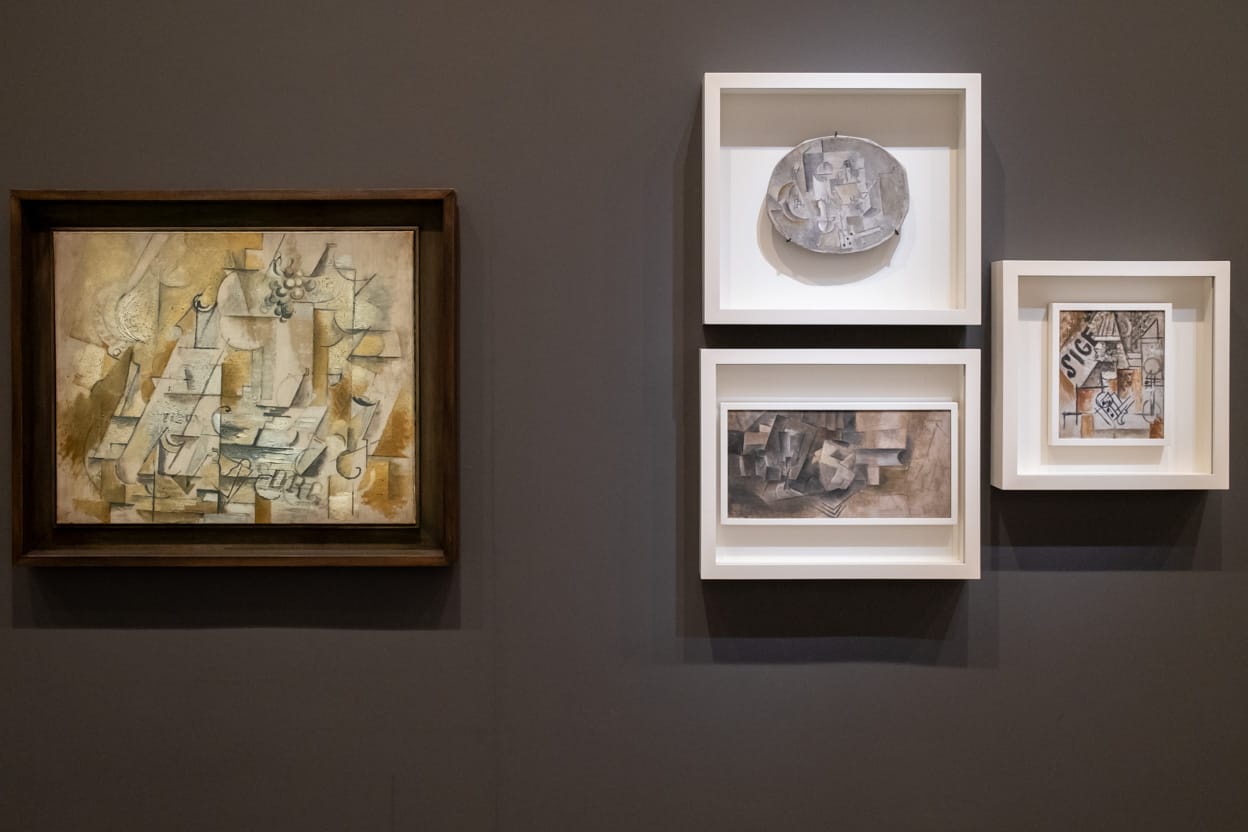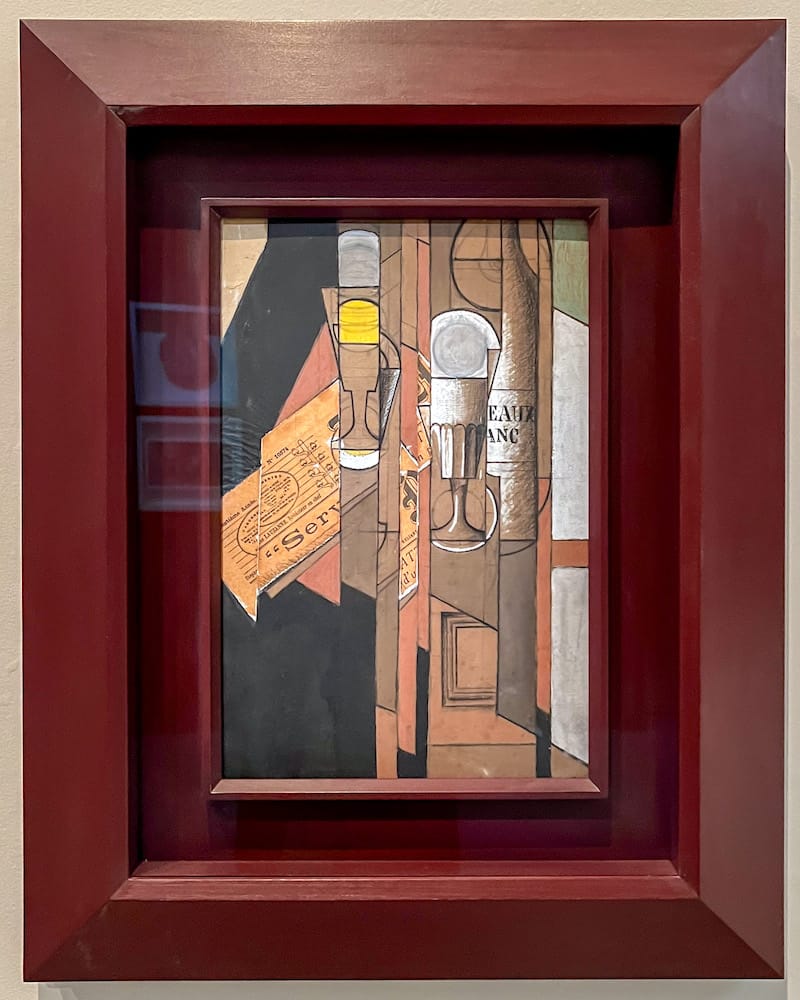
It was pouring with rain when I made my way to the Musée du Luxembourg and I almost called it a day. I’m glad I didn’t, because the exhibition “Gertrude Stein and Pablo Picasso. The Invention of Language” was really interesting. The title is a bit misleading though and the exhibition actually consists of two exhibitions. The first is dedicated to the relationship between Gertrude Stein and Pablo Picasso, the second explores the relationship between art and language in post-war art.
Gertrude Stein was born in 1874 and spent much of her childhood in Oakland, California. She studied at Radcliffe College, the former female-only sister institution of the male-only Harvard College (*), where she was a student of psychologist William James. She subsequently enrolled at John Hopkins Medical School, but dropped out in her fourth year, because medical school bored her.
In 1903 Gertrude and her brother Leo moved to Paris. In the following years they accumulated a large and important art collection. I always find it amusing to see photographs from that period of living rooms with walls full of paintings by Cézanne, Renoir, Matisse, Braque, Picasso and so on. At some point people LIVED among these artworks. In 1913 Leo Stein moved to Italy and the collection was divided between the two siblings. Gertrude Stein continued to live in the apartment at the rue de Fleurus. Every Saturday evening she organized a salon, which was frequented by everyone from Ernest Hemingway and F. Scott Fitzgerald to Francis Picabia, Henri Matisse, Pablo Picasso and Georges Braque.
In 1905 Leo Stein had discovered the work of a young Spanish artist, Pablo Picasso, and after a visit to his studio, Gertrude Stein and Picasso struck up a friendship, which would last until Stein’s death in 1946. For Picasso, Stein’s early patronage and friendship was critical to his success.
The first rooms of the exhibition examine the friendship between Gertrude Stein and Pablo Picasso. Unfortunately the portrait that Picasso painted of Gertrude Stein (1905-06) and which should have been the centrepiece of the exhibition is missing. It is part of the permanent collection of the Metropolitan Museum of Art in New York. It is a striking portrait and generally seen as a precursor to the “Demoiselles d’Avignon” (1907). Fortunately there is much else to enjoy, including a wonderful collage by Juan Gris.

Shortly after arriving in Paris Gertrude Stein embarked upon her writing career. In 1906 she published “Three Lives”, which established her as an experimental writer in avant-garde circles. In 1902 she began work on “The Making of Americans”, which she intended as her magnum opus and would not finish until 1911. I once borrowed it from a library, but only read a couple of pages. Even though I understand, or think I understand, what she was trying to do with language, I found it hard-going. I think Stein’s ideas about writing, and how writing is written, are better served by her experimental prose poems, collected in “Tender Buttons” (1912), which unfortunately appears to be out of print.
For Gertrude Stein language was not a medium. She treated words like objects. As she wrote of Picasso: “Pablo is doing abstract portraits in painting. I am trying to do abstract portraits in my medium, words.” She would look at an object from different angles and try to render it in words without recourse to its preexisting name, using a limited vocabulary and relying heavily on repetition.
Whereas Picasso rose to fame, Stein remained a writer’s writer. She briefly enjoyed some critical and popular acclaim following the publication of “The Autobiography of Alice B. Toklas” (1933), which is among her most accessible works, and her opera “Four Saints in Three Acts” (1934). In 1934-35 she toured the U.S. giving lectures in New York and Chicago and at Harvard, Princeton and Berkeley. She was also invited to have tea at the White House with the President’s wife, Eleanor Roosevelt.
In the long run Gertrude Stein’s ideas have proved to be more influential than Picasso’s, at least that is the contention of the exhibition, with which I agree to a certain extent. Picasso is commonly regarded as the archetypal modern genius, his works change hands for record prices at auctions, but very few contemporary artists draw on cubism. The only artists I can think of are George Condo and David Hockney in his photo collages. The ideas of Gertrude Stein, however, live on in the work of many artists, even though they may never have read any of her work.
Gertrude Stein’s legacy and influence is the subject of the second and largest section of the exhibition, with works by Joseph Kosuth, Hanne Darboven and Bruce Nauman, including “Good Boy, Bad Boy” (1985-86), which I was happy to see again.
By way of John Cage and the artists associated with Black Mountain College Gertrude Stein’s work would leave a mark on a generation of American artists. Initially her ideas found their way into music and the performing arts. The exhibition includes excerpts from performances by Lucinda Childs, Yvonne Rainer and Trisha Brown. Stein’s ideas then spread into the visual arts, minimalism, Fluxus, conceptual art and Pop Art. Various artists, including Robert Rauschenberg, Nam June Paik and Andy Warhol, have paid tribute to Gertrude Stein by including her portrait into one of their works, marking her status as an American icon. Gertrude Stein continues to inspire new generations of artists, as can be seen in the show’s final room.
I must say that I was not expecting to see works by Bruce Nauman, Carl Andre and Jasper Johns, when I saw the poster for “Gertrude Stein and Pablo Picasso. The Invention of Language”, but it makes for an interesting and rewarding exhibition.
Gertrude Stein et Pablo Picasso. L’invention du langage is at the Musée du Luxembourg, Paris until 28 January 2024.
(*) Amazingly it wasn’t until 1999 (!) that Radcliffe College was fully absorbed into Harvard University.
Links
An excerpt from Adam Gopnik’s introduction to “Paris France” by Gertrude Stein.